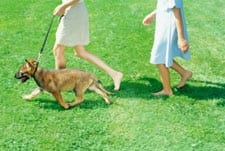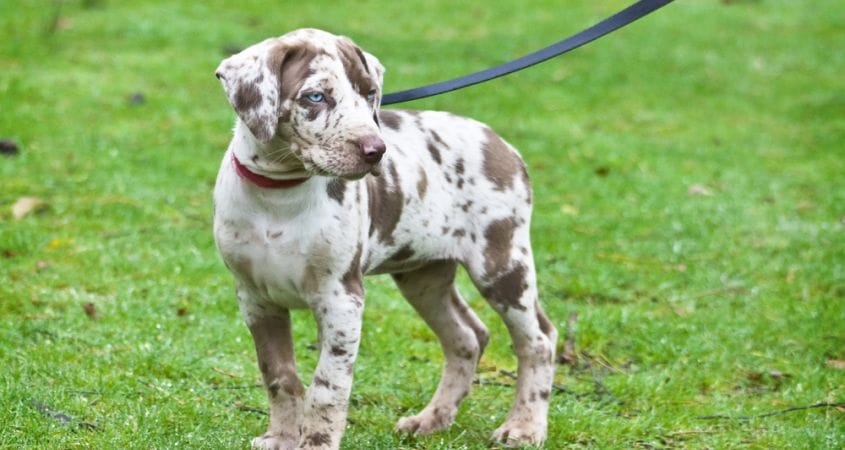by Martin Deeley
Patience is Key
The one thing I find about training dogs is that there are no hard and fast rules. Some dogs take to a collar and leash easily and some do not. Some owners have to put their dogs on a leash the moment they get them—especially if they live in apartments and there are leash laws—and some may not put their dog on a leash for a few months.
I have worked with many different dogs and owners over the years, and the most important features of introducing a leash is patience, calmness, confidence, taking it slowly (at the pace and temperament of the dog) and using ways to overcome any fears or concerns by the dog.
Pick the Right Leash and Collar
To get your dog walking on a leash you first need a collar and a leash. Sounds like an obvious step, but there are many different types out there. Initially, I prefer a light flat collar and a light leash for a young pup. We can move onto other forms of collar later if required.
Take Baby Steps
The first step is to get your dog familiar and accustomed to a collar. Try to avoid problems and situations where your pup could get concerned, fearful or even have a temper tantrum. Just attaching a collar and/or a leash can do this. So put the collar on when there are other things that will occupy his mind and he has to think about.
Attach the collar when your pup is going outside to be in the yard with you or even in the home when you are interacting with him. Put it on snug, but not so tight that it is uncomfortable and irritating. In other words, he should forget about it as you are getting his attention and interacting to take his mind off the wearing of the collar.
Put it on at mealtime or when you are doing some basic training. Very quickly he will come to accept the feeling of the collar and leash—especially if it is related to food—and you can then move to the next stage. One thing to look out for is if he scratches at the collar. If he does this, gain his attention and encourage him to simply follow you or get him to play with a toy so he forgets the irritation.
Associate the Leash with Playtime
With some dogs the moment you pick that leash up and he feels some tension he can go into his ‘I am a fish on the end of a hook’ antics. So, after attaching the leash let him run around dragging it. You should always be supervising this to avoid any possible tangling.

It also helps to have another dog around to engage in play while the leash is on. If you have no other dog, then play with him or go through some fun training routine, such as a small retrieve with a toy or sits and downs with a treat. When he is doing this and looks comfortable, occasionally pick up the leash and call him to you. Do it gently and encourage him to come up to you.
Treats are great, but always make sure they are small morsels and not big treats that he then spends time chewing.
Encourage your Puppy
When first holding the leash, do not attempt to get him to walk at heel yet. If he does that naturally, great, but if he doesn’t do not be tempted to yank on the leash to get him to do so. Do everything calmly and gently. Sometimes even just standing still or kneeling down while he figures out what is happening is a good idea.
Give him time to process all this information regarding what the leash is and does. Let him gain confidence in you, and then in the leash and himself. You can even use a treat held in your hand down by your side at his head level to get him walking alongside you on the leash, and then occasionally make him stop and sit for the treat.
Some dogs can sit and decide not to move. In this instance, walk a few steps away, go down on one knee and encourage him to come to you using a treat. Then set off walking again. For many pups with concerns, and even those without them, the collar and leash can be a little restricting and can create resistance in your dog. Some dogs may walk alongside you and not leave you off leash, but when they have a leash on they behave differently.
Take your time and keep your cool, but be persistent in what you do to achieve the results you want. Even if the results are only a small step towards what you wish to achieve, in time, the small steps become the big ones you seek. Very quickly you will find your dog accepting the leash and eventually he will come to walk nicely on it as well.
What leash and collar have you used to train your puppy?











